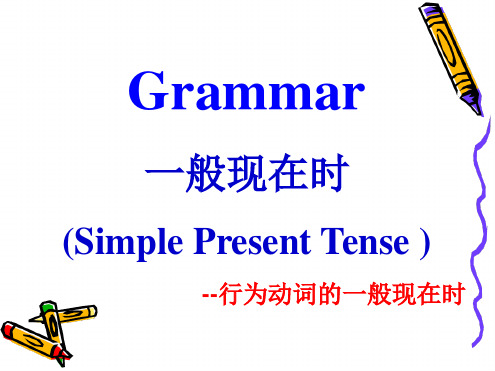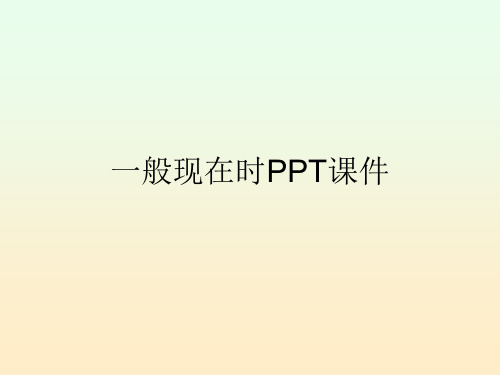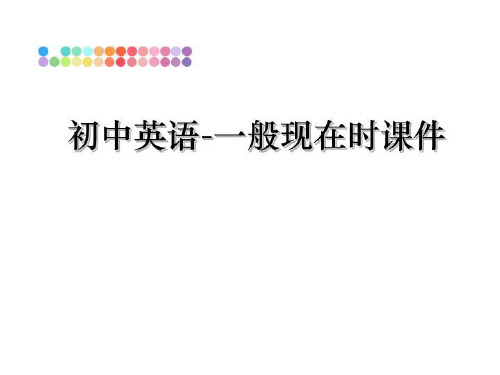初中英语语法之一般现在时趣味讲解 (共18张ppt)
合集下载
七年级英语一般现在时PPT课件.ppt

7. I often __p_l_a_yfootball at weekends. (play) 8. Simon's father often __w__a_t_cfhooetsball games on
TV. (watch)
9. Millie __r_e_a_d_ sbooks at home. (read)
2、连系动词 例句:He is ten years old .
I feel happy .
3、助动词 例句:Do you have a sister?
He doesn't speak English.
4、情态动词
例句:We must go now.
She can speak English.
一般现在时的构成:
My name is Amy. He is ten years old.
---be动词的一般现在时。 I often play football after school.
He watches TV every day. -----行为动词的一般现在时
动词的种类
行为动词的一般现在时的构成:(看例句并总结规律, 注意观察红色和蓝色字体。) 1、I play football every day . 2、You play football every day . 3、My friends play football every day . 4、He plays football every day . 5、Tom plays football every day . 6、My brother plays football every day . 总结规律: 当主语是第一、第二人称和第三人称复数时,行为动 词使用其原形。当主语是第三人称单数时,行为动词 使用其第三人称单数形式。 行为动词一般现在时的第三人称单数形式
《一般现在时讲解》课件

一般现在时可以用来描述当前的情况或状态,例如“我现在很开心”、“她现在 是一名学生”等。这种时态强调的是当前的情况或状态,而不是过去或未来的变 化。
表示客观事实或普遍真理
总结词
描述不受时间影响的客观事实或普遍真理。
详细描述
一般现在时可以用来描述不受时间影响的客观事实或普遍真理,例如“地球是圆的”、“水在100摄氏度下沸腾 ”等。这种时态强调的是事实的普遍性和客观性,不会因为时间而改变。
I eat an apple every day. (我每天吃 一个苹果。)
结构
一般现在时的基本结构是“主语+谓 语+(宾语)+(其他成分)”,其中 谓语动词以原形或第三人称单数形式 出现。
一般现在时的特点
01
02
03
强调现在
一般现在时强调当前时间 点,表示动作或状态正在 发生或存在。
普遍性
一般现在时用于描述普遍 存在的真理、事实或习惯 性行为,不受时间限制。
总结词
动词形式不同
详细描述
一般现在时的动词形式为原型,而一般将 来时的动词形式需要用will+动词原型。
与现在进行时的对比
总结词
动作状态不同
详细描述
一般现在时表示现在的动作或状态,强调动作的持续性 ;而现在进行时表示正在进行的动作或状态,强调动作 的进行过程。
总结词
用法侧重不同
详细描述
一般现在时更侧重于描述习惯性、经常性的动作或状态 ,而现在进行时则侧重于描述当前正在发生的动作或状 态。
一般现在时的用法
表示习惯性或经常发生的动作
总结词
描述日常生活中的常见行为或习惯。
详细描述
一般现在时用于描述日常生活中的常见行为或习惯,例如“我每天早上起床” 、“他每周去健身房锻炼”等。这种时态强调行为的频繁性或习惯性,而不是 特定的一次性事件。
表示客观事实或普遍真理
总结词
描述不受时间影响的客观事实或普遍真理。
详细描述
一般现在时可以用来描述不受时间影响的客观事实或普遍真理,例如“地球是圆的”、“水在100摄氏度下沸腾 ”等。这种时态强调的是事实的普遍性和客观性,不会因为时间而改变。
I eat an apple every day. (我每天吃 一个苹果。)
结构
一般现在时的基本结构是“主语+谓 语+(宾语)+(其他成分)”,其中 谓语动词以原形或第三人称单数形式 出现。
一般现在时的特点
01
02
03
强调现在
一般现在时强调当前时间 点,表示动作或状态正在 发生或存在。
普遍性
一般现在时用于描述普遍 存在的真理、事实或习惯 性行为,不受时间限制。
总结词
动词形式不同
详细描述
一般现在时的动词形式为原型,而一般将 来时的动词形式需要用will+动词原型。
与现在进行时的对比
总结词
动作状态不同
详细描述
一般现在时表示现在的动作或状态,强调动作的持续性 ;而现在进行时表示正在进行的动作或状态,强调动作 的进行过程。
总结词
用法侧重不同
详细描述
一般现在时更侧重于描述习惯性、经常性的动作或状态 ,而现在进行时则侧重于描述当前正在发生的动作或状 态。
一般现在时的用法
表示习惯性或经常发生的动作
总结词
描述日常生活中的常见行为或习惯。
详细描述
一般现在时用于描述日常生活中的常见行为或习惯,例如“我每天早上起床” 、“他每周去健身房锻炼”等。这种时态强调行为的频繁性或习惯性,而不是 特定的一次性事件。
一般现在时精讲ppt课件

20
Change the following sentences after the models.
Model 1: I like fish. (meat) I don’t like meat.
Model 2. He likes reading. (writing) He doesn’t like writing.
一般现在时
表示现在经常反复发生的动作、存 在的状态或习惯性的动作的时态。
完整版ppt课件
1
• 常与一般现在时连用的 词:
完整版ppt课件
2
1、every系列
• every
• day • year • month • week • morning • afternoon • evening
完整版ppt课件
3.表主语具备的性格和能力等: e.g. She likes noodles. They speak French.
4.表示不受时间限制的普遍真理和自然规律: e.g. Two and four is six. The moon goes around the earth.
完整版ppt课件
6
一般现在时的构成
4. You ___li_k_e__(like) fish.
But he _d_o_e_s_n_’t__li_k_e_(not l完ik疑问句
• 一般说来,英语中共有四种问句,分 别是:
1、一般疑问句
2、特殊疑问句
3、选择疑问句
4、反意义疑问句
今天我们来学习一般疑问句。那么,什么是一般疑问句 呢?我们一起来听听一般疑问句的自白:
2. I ___g_o___(go) swimming on Sunday.
一般现在时ppt课件完整版

不可数名词作主语时,谓语动词用单数 形式。
可数名词单数作主语时,谓语动词也用 单数形式。
例如:Water is essential for life.(水 对生命至关重要。)/ A book is on the table.(一本书在桌子上。)
例外情况总结
当主语为并列主语时,谓语动词的数要与靠近它的主语保持一致。
练习3答案
reads。解析:主语 She 是第三人称单数 ,且时间状语为 on weekends,表示经 常性动作,所以谓语动词要用单数形式 reads。
THANKS
时间状语分类及举例
表示经常性或习惯性的动作
always, usually, often, sometimes
表示现在的状态或特征
now, at present, these days
表示普遍真理或客观事实
in general, as a rule
频率副词分类及举例
01
高频副词
always, constantly, continually
注意区分完全否定和部分否定。完全 否定表示全部否定,而部分否定表示 部分否定。例如,“None of the students passed the exam.”(没 有一个学生通过了考试)是完全否定 ;“Not all of the students passed the exam.”(并非所有学生都通过 了考试)是部分否定。
does he work?等。
动词短语和情态动词的变化规则
03
动词短语中的动词和情态动词后接动词原形,如I can swim,
they often go out等。
02 肯定句结构与用法
主语+动词原形+其他成分
(完整版)一般现在时PPT课件.ppt

7. Tom can not walk fast because he _c_a_r_r_ie_s(carry) a heavy box.
用动词的适当形式填空
1.She ____(go) to school at eight o’clock.
2. He usually _____ up at 17:00.(get )
直接加s
Fly-flies;ห้องสมุดไป่ตู้stay-stays
• 第三节 • 特殊疑问句
• I clean the window at home on Saturdays.
• 1、对主语提问:
• Who cleans the window at home on Saturdays?
• 2、对宾语提问:
Has David got a goal?
7. We have four lessons.(否定句) We don’t have four lessons.
8. Nancy doesn’t run fast (肯定句)
Nancy runs fast. 9. My dog runs fast. 否定句:My dog doesn’t run fast.
5. Danny_s_t_u_d_ie_s__(study) English, Chinese, Maths, Science and Art at school.
6. Mike sometimes g_o__e_s_(go) to the park with his sister.
7. At eight at night, she w__a_tc_hes (watch) TV with his parents. 8. _D_o_e_s_ Mike r_e_a_d_(read) English every day?
七年级一般现在时课件PPT

示例
Do you like apples? 你喜 欢苹果吗?
Am/Is/Are引导的一般疑问句
01
结构
Am/Is/Are + 主语 + 其他?
02
用法
用于询问对方或第三方的身份、特征或状态,其中Am用于第一人称单
数,Is用于第三人称单数和不可数名词,Are用于其他人称和复数。
03
示例
Are they your friends? 他们是你的朋友吗?
用所给动词的适当形式填空
2. My father _______ (work) in a bank. He _______ (go) to work by bus every day.
07
总结回顾与拓展延伸
重点内容回顾
01
02
03
04
一般现在时的定义:表示经常 性、习惯性或普遍性的动作或 状态,以及客观真理或事实。
示例与练习
示例
What do you usually do on weekends? 你周末通常做什 么?
练习
根据所给情境,构造特殊疑问句并给出相应回答。例如,针 对“我昨天去了图书馆”这一情境,可以构造特殊疑问句 “Where did you go yesterday?”并回答“I went to the library yesterday.”。
示例与练习
示例:将陈述句“He likes
playing basketball.”改为一
般疑问句。
01
答案:Does he like playing
basketball?
02
练习:将以下陈述句改为一般
疑问句。
03
She has a new bike.
《一般现在时》课件

主语 + 现在时动词(第三人称单数加-s)
主语 + do not/does not + 现在时动词
3 疑问句
Do/Does + 主语 + 现在时动词?
一般现在时的用法
1
描述现在经常发生的动作
2
She always drinks coffee in the morning.
3
描述习惯或常规
4
I usually go to bed at 10 o'clock.
描述现在正在进行的动作
I am studying English.
描述客观事实或真理
The sun rises in the e词需要加-s,例如:He studies Eng lish.
否定句和疑问句的构成
否定句和疑问句需使用助动词do/does,并把其 放在主语之前,例如:I don't like coffee. Does she like tea?
《一般现在时》PPT课件
一般现在时是描述现在正在进行或经常发生的动作的时态,也常用于表示客 观事实、真理和习惯。
什么是一般现在时
简称现在时
用于描述当前正在进行或经常发生的动作。
描述客观事实、真理、习惯等
一般现在时也常用于描述客观存在的事实、普遍的真理和个人的习惯。
一般现在时的构成
1 肯定句
2 否定句
一般现在时课件.ppt

2. Kate comes from America. Kate works with Peter Kate doesn’t come from America.Kate doesn’t work with Peter.
3. I am Chinese, and I am a student.
I am not Chinese, and I am not a student 4. They know each other.
have
looks; goes; gives; flies;
has
gets
EX2 1.Tom often___( get ) up at six in the moarth __( go) around the sun .
lives
3.Mary’s parent __(live ) in Beijing .
draws
4. She ___ (draw) very well.
Eg: 1.I get up at six in the morning.
我在早上六点钟起床。 2.You go to work at eight .
你在八点去上班。
3.Tom goes to school by bike.
汤姆骑自行车去学校。
eg: She lives in Ningbo. 她住在宁波。
2、以/s/ /z/ 等音素结尾的动词,词尾加 -es ,如词尾为e, 只加-s. 读作 /iz /如:
teach------ teaches,
wash----- washes.
eg: My mother washes the coat.我母亲洗了大衣。
1.Be 的用法:
I用 am, you用are, is用于他 (he)、她(she) 、它(it),复数 (we,you,they)全部都用 are.
3. I am Chinese, and I am a student.
I am not Chinese, and I am not a student 4. They know each other.
have
looks; goes; gives; flies;
has
gets
EX2 1.Tom often___( get ) up at six in the moarth __( go) around the sun .
lives
3.Mary’s parent __(live ) in Beijing .
draws
4. She ___ (draw) very well.
Eg: 1.I get up at six in the morning.
我在早上六点钟起床。 2.You go to work at eight .
你在八点去上班。
3.Tom goes to school by bike.
汤姆骑自行车去学校。
eg: She lives in Ningbo. 她住在宁波。
2、以/s/ /z/ 等音素结尾的动词,词尾加 -es ,如词尾为e, 只加-s. 读作 /iz /如:
teach------ teaches,
wash----- washes.
eg: My mother washes the coat.我母亲洗了大衣。
1.Be 的用法:
I用 am, you用are, is用于他 (he)、她(she) 、它(it),复数 (we,you,they)全部都用 are.
一般现在时讲解课件ppt

• 5.She has lunch at home. She doesn’t have lunch at home. Does she have lunch at home?
经营者提供商品或者服务有欺诈行为 的,应 当按照 消费者 的要求 增加赔 偿其受 到的损 失,增 加赔偿 的金额 为消费 者购买 商品的 价款或 接受服 务的费 用
• 3) 用于格言或警句中。 • 例如: • Where there is a will, there is a way.有志者
事竟成。
• 4) 用于表示现在时刻的状态、能力、性格、 个性。
• 例如:
• She is a good girl and always help others. 她是一个好女孩,经常帮助别人。
• (2) 当句子中即没有be动词,也没有情 态动词时,则在主语前加助动词do, does 变成问句;在主语后谓语动词前加助动词 don’t, doesn’t变成否定句,助动词后的谓 语动词要变成动词原形。
经营者提供商品或者服务有欺诈行为 的,应 当按照 消费者 的要求 增加赔 偿其受 到的损 失,增 加赔偿 的金额 为消费 者购买 商品的 价款或 接受服 务的费 用
___________________________________________________
经营者提供商品或者服务有欺诈行为 的,应 当按照 消费者 的要求 增加赔 偿其受 到的损 失,增 加赔偿 的金额 为消费 者购买 商品的 价款或 接受服 务的费 用
(3)以“辅音字母加 - y”结尾的动词,要先变y为i 再加-es.
try---tries study---studies cry---cries fly--flies 2.不规则变化:be---- is have----has
经营者提供商品或者服务有欺诈行为 的,应 当按照 消费者 的要求 增加赔 偿其受 到的损 失,增 加赔偿 的金额 为消费 者购买 商品的 价款或 接受服 务的费 用
• 3) 用于格言或警句中。 • 例如: • Where there is a will, there is a way.有志者
事竟成。
• 4) 用于表示现在时刻的状态、能力、性格、 个性。
• 例如:
• She is a good girl and always help others. 她是一个好女孩,经常帮助别人。
• (2) 当句子中即没有be动词,也没有情 态动词时,则在主语前加助动词do, does 变成问句;在主语后谓语动词前加助动词 don’t, doesn’t变成否定句,助动词后的谓 语动词要变成动词原形。
经营者提供商品或者服务有欺诈行为 的,应 当按照 消费者 的要求 增加赔 偿其受 到的损 失,增 加赔偿 的金额 为消费 者购买 商品的 价款或 接受服 务的费 用
___________________________________________________
经营者提供商品或者服务有欺诈行为 的,应 当按照 消费者 的要求 增加赔 偿其受 到的损 失,增 加赔偿 的金额 为消费 者购买 商品的 价款或 接受服 务的费 用
(3)以“辅音字母加 - y”结尾的动词,要先变y为i 再加-es.
try---tries study---studies cry---cries fly--flies 2.不规则变化:be---- is have----has
一般现在时与一般过去时ppt(共17张PPT)

played
washed watched
Present — Past
原形 第三人称单数 过去式
cry study
cries studies
cried
studied
worry worries
worried
carry
绿色圃中小学教育网绿色圃中学资源 网
copy
carries copies
carried
时态
一般般过过去去去时时时::: 过去某个个时时间间或或时时间间段
(Thhee SSSiiimmmppplleleePast PTeanstseTT)eennssee))
段发生发的生动的作动或作存或在存的在状 的态。状态。
各时态常用的信息词
一般现在时:
always, usually, often, sometimes ,seldom,
第三人称单数
study- studies
finish- finishes
have- has
go- goes do- does
play-
plays watch-
watches give-
gives
过去式
need- needed
stop- stopped
hope- hoped
play- played try- tried
6. Lucy and Lily often ____re_ad_____(read) books.
7. There _______(is) a football match yesterday afternoon. was
8. Our class ______( go) to the zoo three days
washed watched
Present — Past
原形 第三人称单数 过去式
cry study
cries studies
cried
studied
worry worries
worried
carry
绿色圃中小学教育网绿色圃中学资源 网
copy
carries copies
carried
时态
一般般过过去去去时时时::: 过去某个个时时间间或或时时间间段
(Thhee SSSiiimmmppplleleePast PTeanstseTT)eennssee))
段发生发的生动的作动或作存或在存的在状 的态。状态。
各时态常用的信息词
一般现在时:
always, usually, often, sometimes ,seldom,
第三人称单数
study- studies
finish- finishes
have- has
go- goes do- does
play-
plays watch-
watches give-
gives
过去式
need- needed
stop- stopped
hope- hoped
play- played try- tried
6. Lucy and Lily often ____re_ad_____(read) books.
7. There _______(is) a football match yesterday afternoon. was
8. Our class ______( go) to the zoo three days
最新初中英语-一般现在时课件教学讲义ppt课件

☺一般疑问句:Be+主语+表语?
e.g. Is he a worker? Yes, he is./No, he isn’t. Are you thirteen?
Are they in the classroom? Yes, they are. No, they aren’t.
☺特殊疑问句:疑问词+be+主语?
特殊疑问句:疑问词+ do/does+主语+v.+其他?
e.g. What do you want? (she) What does she want? What time do you have lunch? What time does she have lunch? What do you do? What does she do? How do you spell it? (he) How does he spell it? How do you like Chinese food? How does he like Chinese food? How many tomatoes do you want? How many tomatoes does he want? How do you go to work? (your father) How does your father go to work?
否定句:☺主语(He/She/It)+does +not+v.+其他 e.g. He doesn’t study in a high school. Lucy doesn’t have a pet.
一般疑问句:☺Does+主语(he/she/it)+V.+其他? e.g. Does he study in a high school? Does Lucy have a pet?
e.g. Is he a worker? Yes, he is./No, he isn’t. Are you thirteen?
Are they in the classroom? Yes, they are. No, they aren’t.
☺特殊疑问句:疑问词+be+主语?
特殊疑问句:疑问词+ do/does+主语+v.+其他?
e.g. What do you want? (she) What does she want? What time do you have lunch? What time does she have lunch? What do you do? What does she do? How do you spell it? (he) How does he spell it? How do you like Chinese food? How does he like Chinese food? How many tomatoes do you want? How many tomatoes does he want? How do you go to work? (your father) How does your father go to work?
否定句:☺主语(He/She/It)+does +not+v.+其他 e.g. He doesn’t study in a high school. Lucy doesn’t have a pet.
一般疑问句:☺Does+主语(he/she/it)+V.+其他? e.g. Does he study in a high school? Does Lucy have a pet?
超详细一般现在时讲解ppt课件

→ Can you swim? → I can not swim.
3、 当句子中即没有be动词,也没有情态动 词时,则在主语前加助动词do, does变成问 句;在主语后谓语动词前加助动词don’t, doesn’t变成否定句,助动词后的谓语动 词要变成动词原形。
例:We get up at 7:00 every morning.
初中英语说课稿
一般现在时
八 大
一般过去时 一般将来时 现在进行时
时 现在完成时
态 过去进行时
过去将来时
过去完成时
一般现在时
一、掌握含有be动词的一般现在时的结构。
二、掌握含有实义动词行为动词)的一般现在时的结构。
在含有实义动词的一般现在时中,如果主语是三单,(谓语)动词也要用三单式。
一、一般现在时的基本用法
学生常见错误如下:
(一)be动词与行为动词同时出 现在句子中
(二)单三人称形式易出错 (三)在句式变换时易出错 (四)对do的理解易出错 (五)对主语的数判断有误
(一)be动词与行为动词同时出现在句 子中
(二)单三人称形式易出错
1、 He plaies (play) football very well. 以元音字母加y结尾的动词变单三人称形式 不能把y换成i再加es; 2 、Danny gos (go) to school at 7:10. 与名词变复数不同,变单三人称形式以o结尾
eighteightminusfivethreeminusfive77动词三单式的变化规则动词三单式的变化规则规则变化规则变化一般情况下直接一般情况下直接sworkworkworksaskworksaskasksseeasksseeseesseeschshchsh结尾结尾eseswatchwatchwatchesgowatchesgogoesdogoesdodoeswashdoeswashwasheswashes以辅音字母以辅音字母yy结尾变结尾变yy为为ii加加esestrytrytriesstudytriesstudystudiesflystudiesflyfliesflies不规则变化不规则变化havehavehashas88三一般现在时的句型转换三一般现在时的句型转换11当句子中有当句子中有bebe动词时则把动词时则把bebe动词提到主语动词提到主语的前面变成疑问句的前面变成疑问句
3、 当句子中即没有be动词,也没有情态动 词时,则在主语前加助动词do, does变成问 句;在主语后谓语动词前加助动词don’t, doesn’t变成否定句,助动词后的谓语动 词要变成动词原形。
例:We get up at 7:00 every morning.
初中英语说课稿
一般现在时
八 大
一般过去时 一般将来时 现在进行时
时 现在完成时
态 过去进行时
过去将来时
过去完成时
一般现在时
一、掌握含有be动词的一般现在时的结构。
二、掌握含有实义动词行为动词)的一般现在时的结构。
在含有实义动词的一般现在时中,如果主语是三单,(谓语)动词也要用三单式。
一、一般现在时的基本用法
学生常见错误如下:
(一)be动词与行为动词同时出 现在句子中
(二)单三人称形式易出错 (三)在句式变换时易出错 (四)对do的理解易出错 (五)对主语的数判断有误
(一)be动词与行为动词同时出现在句 子中
(二)单三人称形式易出错
1、 He plaies (play) football very well. 以元音字母加y结尾的动词变单三人称形式 不能把y换成i再加es; 2 、Danny gos (go) to school at 7:10. 与名词变复数不同,变单三人称形式以o结尾
eighteightminusfivethreeminusfive77动词三单式的变化规则动词三单式的变化规则规则变化规则变化一般情况下直接一般情况下直接sworkworkworksaskworksaskasksseeasksseeseesseeschshchsh结尾结尾eseswatchwatchwatchesgowatchesgogoesdogoesdodoeswashdoeswashwasheswashes以辅音字母以辅音字母yy结尾变结尾变yy为为ii加加esestrytrytriesstudytriesstudystudiesflystudiesflyfliesflies不规则变化不规则变化havehavehashas88三一般现在时的句型转换三一般现在时的句型转换11当句子中有当句子中有bebe动词时则把动词时则把bebe动词提到主语动词提到主语的前面变成疑问句的前面变成疑问句
一般现在时PPT课件

Does Kate like singing every morning?
Lily often writes to her uncle in Canada. Does Lily often write to her uncle in
Canada?
2021
20
D. 特殊疑问句: 疑问词+一般疑问句?
2021
9
频率副词在句中的位置:
1. 频率副词用在be动词后。 It is usually hot in summer.
2. 频率副词用在实义动词前。 My father usually walks home.
3. 频率副词用在助动词与实义动词之间。 I will always love you.
like—likes get--gets
go—goes watch--watches study—studies fly--flies play—plays stay--stays have—has be--is
2021
13
Practice one
写出下列单词的第三人称单数形式 live------ __liv_e_s_____ discuss---d_i_sc_u_s_s_e_s have--- ____h_a_s__ hurry--- h_u_r_ri_e_s___ go---- _____g_o_e_s wash--- __w__a_s_h_e_s stay-------- _s_t_a_y_s____ be---___is_____ enjoy------ __e_n_jo_y_s___ collect---- _c_o_ll_e_ct_s_
2021
17
• A. 肯定句: • 主语(I/We/You/They)+动词原形+其他 • 主语(He/She/It)+动词的s形式+其他 We often play basketball in the playground. Mary studies English, Chinese at school.
一般现在时、一般过去时和一般将来时课件(PPT31张)

A. When did B. What time will C. When are D. What time are
8. ---Let’s go to the cinema. There is a good movie.
---Ok. I _A____ you at the school gate at 7 p.m.
1. Long long ago, there ___C_____ four foxes and they lived a happy life together. A. had B. has C. were D. are 2. Could you tell me __C______ a moment ago? A. what were they talking about B. what are they talking about C. what they were talking about D. what they are talking about
e. g. She is going to buy a new bike.
她打算买一辆新的自行车。
1. We will land soon. 2. They will not take off next week. 3. Will he be ready tomorrow? Yes, he will. / No, he won’t.
3. With the development of science and technology, robot cooks __C_______ in our
families in the future.
A. appear
B. appeared
C. will appear D. were appearing
8. ---Let’s go to the cinema. There is a good movie.
---Ok. I _A____ you at the school gate at 7 p.m.
1. Long long ago, there ___C_____ four foxes and they lived a happy life together. A. had B. has C. were D. are 2. Could you tell me __C______ a moment ago? A. what were they talking about B. what are they talking about C. what they were talking about D. what they are talking about
e. g. She is going to buy a new bike.
她打算买一辆新的自行车。
1. We will land soon. 2. They will not take off next week. 3. Will he be ready tomorrow? Yes, he will. / No, he won’t.
3. With the development of science and technology, robot cooks __C_______ in our
families in the future.
A. appear
B. appeared
C. will appear D. were appearing
一般现在时讲解课件

football every day.(正确)
03 一般现在时在肯定句中应 用
陈述句结构分析
主语 + 谓语
基本句型,表示主语的动作或状态。
主语 + 谓语 + 宾语
常用句型,表示主语对宾语的动作。
主语 + 谓语 + 间接宾语 + 直接宾语
双宾语句型,表示主语给间接宾语一个直接宾语。
主语 + 谓语 + 宾语 + 宾语补足语
动词形式变化规则
第三人称单数
在一般现在时中,当主语是第三人称单数时(he/she/it/ 单数名词),谓语动词要用第三人称单数形式,即在动词 原形后加-s或-es。
规则变化
一般情况下,直接在动词后加-s,如:works,plays, lives等。
不规则变化
以s,x,ch,sh结尾的动词,在词尾加-es,如:guesses, fixes,teaches,washes等;以辅音字母+y结尾的动词, 变y为i再加-es,如:studies,tries等。
03
使用场景
一般现在时常用于描述现在或经常性的情况;过去时态则用于回忆、叙
述过去的事件或经历。
与将来时态对比分析
时态区别
一般现在时与将来时态的主要区别 在于动作发生的时间点不同,前者 表示现在或经常性的动作或状态, 后者则表示未来某个时间点或时间 段内将要发生的动作或状态。
动词形式
一般现在时动词使用原形或第三 人称单数形式;将来时态则常使 用will或be going to等结构表示 将要发生的动作。
复合宾语句型,表示主语使宾语保持某种状态或做某事。
肯定句表达功能
描述经常性或习惯性的动作
03 一般现在时在肯定句中应 用
陈述句结构分析
主语 + 谓语
基本句型,表示主语的动作或状态。
主语 + 谓语 + 宾语
常用句型,表示主语对宾语的动作。
主语 + 谓语 + 间接宾语 + 直接宾语
双宾语句型,表示主语给间接宾语一个直接宾语。
主语 + 谓语 + 宾语 + 宾语补足语
动词形式变化规则
第三人称单数
在一般现在时中,当主语是第三人称单数时(he/she/it/ 单数名词),谓语动词要用第三人称单数形式,即在动词 原形后加-s或-es。
规则变化
一般情况下,直接在动词后加-s,如:works,plays, lives等。
不规则变化
以s,x,ch,sh结尾的动词,在词尾加-es,如:guesses, fixes,teaches,washes等;以辅音字母+y结尾的动词, 变y为i再加-es,如:studies,tries等。
03
使用场景
一般现在时常用于描述现在或经常性的情况;过去时态则用于回忆、叙
述过去的事件或经历。
与将来时态对比分析
时态区别
一般现在时与将来时态的主要区别 在于动作发生的时间点不同,前者 表示现在或经常性的动作或状态, 后者则表示未来某个时间点或时间 段内将要发生的动作或状态。
动词形式
一般现在时动词使用原形或第三 人称单数形式;将来时态则常使 用will或be going to等结构表示 将要发生的动作。
复合宾语句型,表示主语使宾语保持某种状态或做某事。
肯定句表达功能
描述经常性或习惯性的动作
初中英语语法之一般现在时PPT课件

28
☺ 一般疑问句: Do+主语(非三单)+v.原形+其他? 肯定回答:Yes, 主语+do. 否定回答:No, 主语+don't. 1) _D_o_ you_s_t_a_y (stay) at home on Saturdays? 2) _D_o_ theyh_a_v_e_(have) sports every day? ☺Does+主语(三单)+v.原形+其他?
如果你接受这份工作,他们将和你谈谈细
15
6、表示格言或警句。 例如:Pride goes before a fall. 骄者必败。 注意:此用法如果出现在宾语从句中, 即使主句是过去时,从句谓语也要用 一般现在时。
16
一般现在时表达方法
主要通过谓语动词的变化和用时间词语来 表示,其中最主要的是谓语动词的变化。 一般现在时动词变化的规则是: 当主语为非第三人称单数,谓语动词用原型。 当主语为第三人称单数,谓语动词用第三人 称单数形式。e.g. 1. We often get up early in the morning. 2. My father often gets up early in the
13
4.普遍真理和自然规律: 1) Two and four is six.
二加四等于六。 2)The moon goes around the earth. 月亮绕着地球转。 3)Ten minus two is eight.十减二 等于八。 4)Light travels faster than sound . 光的速度比声音的速度快。
21
4.以辅音字母+o结尾的词,一般情况是在 词尾加es, 读作[z]
☺ 一般疑问句: Do+主语(非三单)+v.原形+其他? 肯定回答:Yes, 主语+do. 否定回答:No, 主语+don't. 1) _D_o_ you_s_t_a_y (stay) at home on Saturdays? 2) _D_o_ theyh_a_v_e_(have) sports every day? ☺Does+主语(三单)+v.原形+其他?
如果你接受这份工作,他们将和你谈谈细
15
6、表示格言或警句。 例如:Pride goes before a fall. 骄者必败。 注意:此用法如果出现在宾语从句中, 即使主句是过去时,从句谓语也要用 一般现在时。
16
一般现在时表达方法
主要通过谓语动词的变化和用时间词语来 表示,其中最主要的是谓语动词的变化。 一般现在时动词变化的规则是: 当主语为非第三人称单数,谓语动词用原型。 当主语为第三人称单数,谓语动词用第三人 称单数形式。e.g. 1. We often get up early in the morning. 2. My father often gets up early in the
13
4.普遍真理和自然规律: 1) Two and four is six.
二加四等于六。 2)The moon goes around the earth. 月亮绕着地球转。 3)Ten minus two is eight.十减二 等于八。 4)Light travels faster than sound . 光的速度比声音的速度快。
21
4.以辅音字母+o结尾的词,一般情况是在 词尾加es, 读作[z]
一般现在时(示范课)ppt课件精选全文

精选课件
27
• 3. Daniel enjoys playing computer games.
• (改为一般疑问句并做肯定回答)
Does Daniel enjoy playing computer games?
Yes, he does.
精选课件
28
补充:some、any
• 一般说来,some 用于肯定句中,any 用于 否定句和疑问句中 。
Change the following sentences after the models.
Model 1: I like fish. (meat) I don’t like meat.
Model 2. He likes reading. (writing) He doesn’t like writing.
改疑问句或否定句时,原句里的some要改成any
There are some books on the desk. (改为否定句)
→There aren’t any books on the desk.
→Are there any books on the desk?
精选课件
29
Why not buy some apples? 为什么不买些苹果呢?
精选课件
26
句型转换
• 1. Mr. Green comes from Shanghai. • (改为一般疑问句)
Does Mr. Green come from Shanghai?
• 2. Millie lives in a flat in Beijing. • (改为否定句)
Millie doesn’t live in a flat in Beijing.
- 1、下载文档前请自行甄别文档内容的完整性,平台不提供额外的编辑、内容补充、找答案等附加服务。
- 2、"仅部分预览"的文档,不可在线预览部分如存在完整性等问题,可反馈申请退款(可完整预览的文档不适用该条件!)。
- 3、如文档侵犯您的权益,请联系客服反馈,我们会尽快为您处理(人工客服工作时间:9:00-18:30)。
看见它们你能想到啥?
三·标志 symbol
频率副词 always ; usually ; often ; sometimes ; 或短语: seldom ; hardly ; never ;once a week;
three times a day...
时间短语:in the morning/afternoon/evening ;
The earth _goes__(go) around the sun.
The sun_rises__(rise) in the east.
1)Knowledge _is__(be) power. 2)It _is__(be) never too old to learn. My teacher told us that light___travels_____ (travel) faster than sound .
6. Jenny _works___ (work)in an office. Her parents _work___(work)in a hospital.
7. We often_play__________(play) in the playgound.
8. There _is_______(be) some water in the bottle.
定义
1.主语+be动词+其他
一
构成 2.主语+实义动词+其他
般
现
1 表示习惯性,经常性的动作
在
用法 2 表示性格,特点,能力或现在的状态
时
3 谚语格言,客观真理永一现
1 频率副词或短语
标志
2 时间短语
1.The plane _takes______(take) off at 9:00 tonight.
What's your name? How old are you? Which grade are you in?? What's your hobby?
接招!!
Duang~~冬天到了,这四不四你啊······
想象中的冬天是这样的 实际是这样的
OK,I’m fine...
I always think that winter is beautiful .In winter, I always make snowmen outside my house. And I like taking pictures.However,in this winter, I just sleep all the day. I usually get up at 11am in the morning,and I take a shower once a month.You may think I'm a lazy boy,but actually, I just can't stand the cold weather.
一般ቤተ መጻሕፍቲ ባይዱ在时
I am a cute girl ,and I am pretty.
We are twins. We like each other. And we always wear the same clothes.
I usually go to the cinema with my friends.
am is are 动词原形、动词的三单形式
动词三单式
1. 一般情况词尾+s
put-
like-
eat-
2. s(随) sh (时) ch (出) x(现) o(哦)结尾的动词,后+es
miss-
wash-
watch-
fix-
go-
3.以辅音字母+y结尾的词 ,先变y为i, 再+es
study-
cry-
2. She and I ___take_____(take) a walk together every evening.
3.I’ll tell him the truth as soon as he _gets______ (get)home. 4. He said the sun _rises___ (rise)in the east and _sets___ (set)in the west. 5.Shanghai _lies___ (lie) in the east of China.
9. He often _has_______(have) dinner at home.
10. Mike sometimes _goes_______ (go)to the park with his sister.
Thanks
every day ; on Sundays…
火眼金睛
I always get up at 6 o'clock. He sometimes goes to work by bus. I do my homework every day. She visits her grandma once a week.
自我介绍: 嗨,大家好。我是一般现在时,今天有幸站在这里同大家做个自我介绍。首 先,我一般出现在三种场合。哪三种呢?对了,“目前的事实或状态、不变 的真理或格言、习惯性的反复性的动作”,嗯哼,就是它们了。另外,我有 两张脸哦,欸,是不是很好奇我有哪两张脸啊?最后,再告诉你们一个秘密, 有时我的出现需要靠你们的火眼金睛来分辨,有时呢,我的出现是有前兆的, 至于具体是什么,那就请大家认真看好了。
